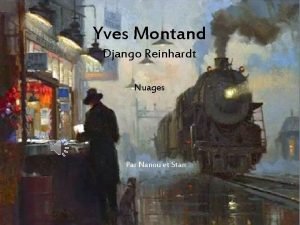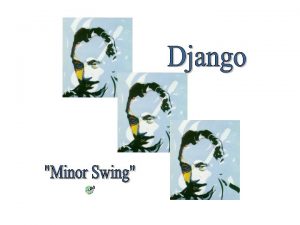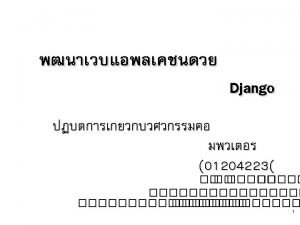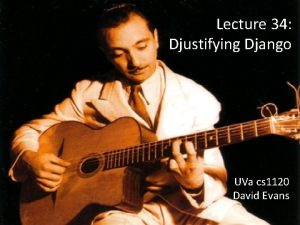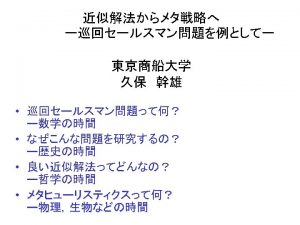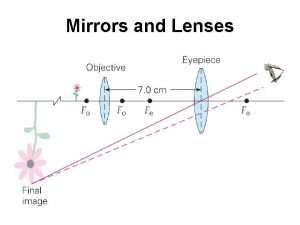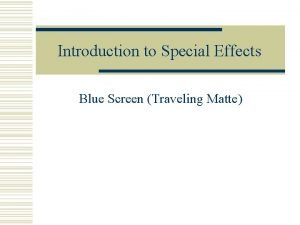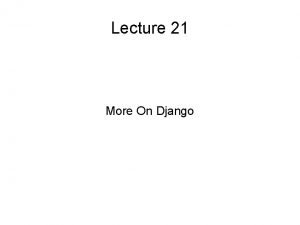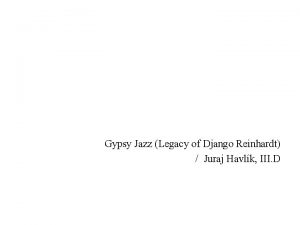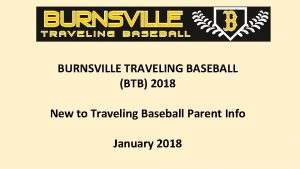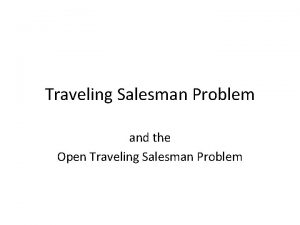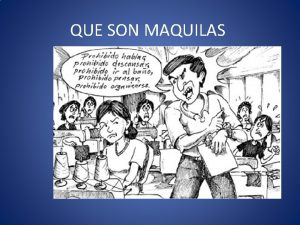Django Reinhardt was the son of a traveling






















- Slides: 22


Django Reinhardt was the son of a traveling entertainer. He grew up in a gypsy settlement outside Paris.


Reinhardt first played violin and later took up guitar, and began working professionally in 1922 with the accordionist Guerino. In 1928, he was badly burned in a caravan fire, which resulted in the mutilation of his left hand. This deprived him of the use of two fingers and led him to devise a unique fingering method to overcome his handicap.


After a period of convalescence, he worked in cafés in Paris and in a duo with the singer Jean Sablon. In 1934, he was a founding member, with Stephane Grappelli, of the ensemble that became known as the Quintette du Hot Club de France.


In the years before World War II the group gained considerable renown through its numerous recordings, and Reinhardt became an international celebrity. He appeared throughout Europe and recorded with many important American musicians who visited the Continent. During the war, while Grappelli lived in Britain, Reinhardt remained in France.


In 1946, he visited England Switzerland, toured the USA as a soloist with Duke Ellington's band (playing an amplified guitar for the first time), and worked in New York. After his return to France, he lived in Samois and toured and recorded with his quintet, which sometimes included Grappelli again.


Reinhardt's grasp of harmony, remarkable technique, and trenchant rhythmic sense made him an excellent accompanist. His incisive support is heard to advantage on Stardust (1935), recorded with Coleman Hawkins.


The rhythmic content of his work became more varied, as in Minor Swing (1947), and his improvised lines more flexible.


The asymmetrical, occasionally violent playing heard in some later performances shows the continual widening of his expressive scope.


A documentary film, Django Reinhardt (1958), was made after his death by the director Paul Paviot. It includes an introduction by Jean Cocteau and features music performed by Grappelli, Rostaing, and Joseph Reinhardt.

The pianist Michel Emer recalls a recording session which took place on March 14 th, 1933 with the singer Eliane de Creus, one of the first to employ Django’s peculiar talents. “We were starting the recording without him when the studio door half opened to admit our guitarist, hiding behind a newspaper. The red light came on and the band began to play. ‘Django produced his guitar from inside the newspaper and launched into a masterly accompaniment without knowing a note of the piece we were doing – and, what’s more, playing to perfection the breaks we had left open for him. ”

Disc 1 Disc 2 Disc 3 Disc 4 • Dinah Parfum Swing Interpretation Bach Daphne • Tiger rag Alabamy Bound Impro on Bach D minor At the Jimmy's bar • I saw stars Minor Swing Bolero de Django Rythme Futur • The continental Viper's Dream My Serenade Begin the Beguine • Avalon Crazy Rhythm You Rascal You Indécision (Undecided) • Smoke rings Honeysuckle Rose Christmas Swing 41 • I've found a new baby Out of nowhere Tea For Two Nuages • Crazy Rhythm Sweet Georgia Brown Blues Pour Vous (Exactly like you) • I've had my moments Bugle Call Rag It Had To Be You Vendredi 13 • Some of these days Between the Devil and the. . . I'm Coming Virginia Petits Mensonges (little white lies) • Djangology I've Got Rhythm Farewell Blues Les Yeux Noirs • I'se a muggin Sweet Sue, Just You Blue Light Blues Sweet Sue, Just You • Oriental Shuffle Hangin' around Boudon I've Got Rhythm Swing de Paris • After you've gone Japanese Sandman Montmartre Oiseaux des Iles • Limehouse blues St-Louis Blues Low Cotton All of Me • Nagasaki Bouncin' around Finess (Night Wind) Belleville • Swing guitars Eddie's Blues I Know That You Know Lentement, Mademoiselle • Goergia on my mind Oh Lady Be Good Solid Old Man Douce Ambiance • Shine Daphne I'll See You In My Dreams Manoir de mes rêves • Sweet chorus I Ain't Got Nobody Echoes of Spain Oui • Rose room Baby Won't You Please Come. . . Naguine Fleur d'Ennui • Body and soul Big Boy Blues Tears Improvisation No 3 part 1 • Mystery pacific Swing Guitars Limehouse Blues Improvisation No 3 part 1 • In a sentimental mood Bill Coleman Blues • Improvisation I Can't Believe That You're In. . .

http: //pages. infinit. net/meuhp/Django. Story. htm

Django Reinhardt was the son of a traveling entertainer and the brother of Joseph Reinhardt. He grew up in a gypsy settlement outside Paris. Reinhardt first played violin and later took up guitar, and began working professionally in 1922 with the accordionist Guerino. In 1928, he was badly burned in a caravan fire, which resulted in the mutilation of his left hand. This deprived him of the use of two fingers and led him to devise a unique fingering method to overcome his handicap. After a period of convalescence, he worked in cafés in Paris and in a duo with the singer Jean Sablon. In 1934, he was a founding member, with Stephane Grappelli, of the ensemble that became known as the Quintette du Hot Club de France. In the years before World War II the group gained considerable renown through its numerous recordings, and Reinhardt became an international celebrity. He appeared throughout Europe and recorded with many important American musicians who visited the Continent. During the war, while Grappelli lived in Britain, Reinhardt remained in France. He led a big band, then achieved considerable success as the leader of a new quintet in which the clarinetist Hubert. Rostaing took Grappelli's place. He also became interested in composition and, with Andre Hodeir, arranged the music for the film Le Village de la Colere (1946). In 1946, he visited England Switzerland, toured the USA as a soloist with Duke Ellington's band (playing an amplified guitar for the first time), and worked in New York. After his return to France, he lived in Samois and toured and recorded with his quintet, which sometimes included Grappelli again. Reinhardt's grasp of harmony, remarkable technique, and trenchant rhythmic sense made him an excellent accompanist. His incisive support is heard to advantage on Stardust (1935), recorded with Coleman Hawkins. He later developed into a soloist of unique character, creating a deeply personal style out of his own cultural patrimony. By 1937, when he recorded Chicago with the Quintette, he was established as the first outstanding European jazz musician, a stylist with great melodic resourcefulness and a mastery of inflection. He was a gifted composer of short evocative pieces and had a flair for pacing a performance so the maximum variety could be wrung from it without compromising its homogeneity; an excellent example of this is St. Louis Blues (1937). Endowed with remarkable sensitivity, he could work with visiting American performers without forsaking his own essentially romantic style. In the 1940 s, he switched to the electric guitar. However, this did not coarsen his playing since he used its power with discretion. The rhythmic content of his work became more varied, as in Minor Swing (1947), and his improvised lines more flexible. The asymmetrical, occasionally violent playing heard in some later performances shows the continual widening of his expressive scope. A documentary film, Django Reinhardt (1958), was made after his death by the director Paul Paviot. It includes an introduction by Jean Cocteau and features music performed by Grappelli, Rostaing, and Joseph Reinhardt. Django's two sons, Lousson and Babik, were both fine guitarists, and after their father's death, Babik established a reputation in his own right. The New Grove Dictionary of Jazz, Macmillan Publishers Ltd. All rights reserved. For personal, non-commercial use only. Copying or other reproduction is prohibited.
 Yves reinhardt
Yves reinhardt Django reinhardt documentary
Django reinhardt documentary Htw lsd
Htw lsd Christina reinhardt
Christina reinhardt Dr martin reinhardt
Dr martin reinhardt Helge reinhardt
Helge reinhardt C reinhardt
C reinhardt Mtv django
Mtv django Little sussie
Little sussie Load balancer django
Load balancer django Building a social network with python django
Building a social network with python django Django orm
Django orm Django graph visualization
Django graph visualization Django web socket
Django web socket Pythonclassroomdiary
Pythonclassroomdiary Python django template
Python django template Travelling is very popular nowadays.
Travelling is very popular nowadays. Traveling salesman problem erklärung
Traveling salesman problem erklärung A stationary police officer directs radio waves
A stationary police officer directs radio waves Mirror lens equation
Mirror lens equation Travelling mattes
Travelling mattes To wait seemed foolish when decisive action was required
To wait seemed foolish when decisive action was required Bitonic euclidean traveling salesman problem
Bitonic euclidean traveling salesman problem
